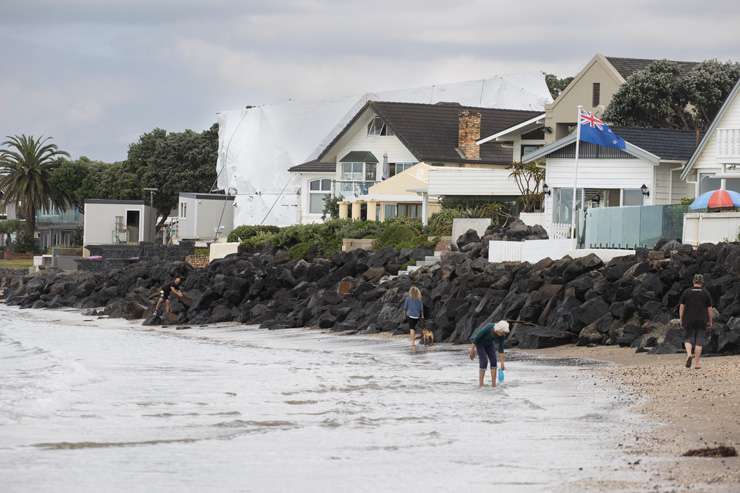The challenges thrown up by Covid look like a walk in the park compared to those being seen since Auckland’s anniversary weekend floods, says Kristina Marmont, branch manager for Milford Harcourts Cooper & Co.
Parts of Milford, a popular beach suburb on the North Shore, were badly hit by the onslaught of rain with some homes in some Milford streets seeing water up to their roofline.
Marmont says agents are learning on the job daily about legalities and other issues after the floods.
Damaged properties are still being listed and are selling, she says, but many people in the suburb are having to navigate what an Auckland Council coloured sticker means, and some who had properties appraised prior to the floods may now find the value is much less.
Start your property search
It’s hard to know the value, however, because there is nothing to compare to, Marmont says. Her office is recommending auctions for those who are selling and she hopes that in a few weeks there will be a better idea of where the market sits around value.
Her branch had 45 rental properties affected by flooding and had another 10 homes that were expected to go to market were no longer able to be put on the market, says Marmont.
A lot of properties in the area have had white stickers which means there may have been only minimal water egress in the garage or other surface flooding and Marmont says banks should not have a problem lending on these homes.
Read more:
- ‘You can’t be here anymore’: Plea to start moving entire communities out of risk zones now
- Cyclone Gabrielle fallout: ‘We look after over 200 rentals. I don’t know how many we’ve got left’
- Kerikeri resort home sells in the middle of cyclone chaos for $2.3m
With a yellow-stickered home, where the damage may be moderate and access restricted, banks will want a report from the insurance company as to what happened, then the bank will determine if it will lend on the property.
Homes that are red-stickered saw potentially severe damage and banks are rejecting lending on these properties at the moment because of the question mark around the value, says Marmont.
She says her agents have been dealing with traumatised and grieving people who have lost a lot and are helping talk them through their options.
“It's been devastating. They’ve lost a lot and so we're just trying to navigate it with them, hold their hand, walk them through the process and we're learning as we go with them so it's definitely case by case.”
She also points out many homes in Milford did not flood and says even in the same street one home may have been affected but not another and her staff are becoming knowledgeable about different scenarios.
For owners who need to sell, perhaps because they have bought another property or are leaving Auckland, she says there are buyers out there.
“We've seen some investors coming back in because they have realised that there's a lot of rental properties in demand and they've also realised there could be a good buy out there.”
First-home buyers are also looking and are having to talk with the banks on a case-by-case basis as to whether they can get lending.

The seawall protecting houses along Milford Beach. Photo / Brett Phibbs
Milford is a desirable location and will bounce back, Marmont says. Already February is shaping up to be a strong month for listings with more on the books than for the same time last year.
The agency is asking anyone listing to sign a disclaimer about whether they had flood damage, and if so what the damage was, she adds.
Mortgage Express mortgage adviser Suzanne Isherwood says she had a customer from the North Shore last week whose house has been red-stickered who wanted to buy a rental property using his equity in the property but could not, even though his house was largely unaffected.
“When I asked him what the problem was with his home it had some minor flooding in the garage but he was at the bottom of a cliff and at the top had a house that was teetering on the edge so it was the house above that that was a potential risk to his home, so he can't go back until that house has been removed at the top.”
The man had wanted to buy an investment property to live in until his situation was resolved but was unable to use the equity in his house because of the red sticker.
Isherwood says most insurance companies are giving payouts of $20,000 to people affected to cover rental and expenses in the short term, but with a bond to pay and rents of up to $1000 a week that might only last eight weeks, and many are still paying mortgages on their damaged homes.
Combined with that is the rental shortage. She knows of people who have moved into central city apartments but that’s not suitable for people with pets.
“It’s a bit of a minefield at the moment for these poor people.”
She advises people who are unsure what to do to reach out: “A problem shared is a problem halved, as soon as you start facing it it's not as big a problem, get people around you to help.”
A mortgage broker can have an initial conversation and advise where to go to and also around what the bank needs.
For those selling, that could be insurance company commentary on the property and for those still paying mortgages banks may assist with a mortgage holiday or interest-free option.
- Click here to find properties for sale in Auckland's North Shore

















































































